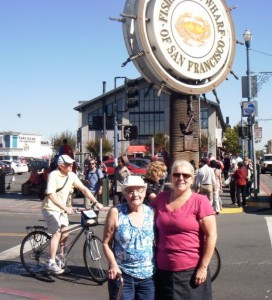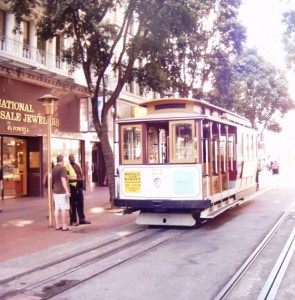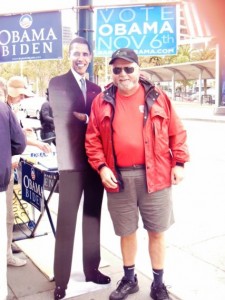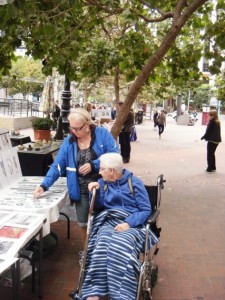October 20, 2012 –

Week 1 of our southern journey was lots of fun and interesting as we left I-5 on Day 2 and headed to the Oregon Coast, something Sylvia always wanted to see. The weather was kind of iffy. And a bit wet but what would you expect on the Oregon coast in Mid-October. This was a great drive, so much to see, we had lots of time and everyone really enjoyed the scenic vistas. Once we crossed into California we headed over from Hwy 101 to Hwy 1, wow! And folks thought Baja had narrow roads!

After camping on a bluff overlooking the ocean we continued south and picked up Hwy 101 again, the road we took returning us to the highway was beautiful driving through a forest then into wine country. We entered San Francisco crossing the Golden Gate Bridge which felt like driving across the Patullo except with 3 lanes, Lisa particularly enjoyed the curbside view of the ocean below.

After settling into the San Francisco RV Resort (thank you everyone for your many suggestions) we spent the next 3 days touring around San Francisco. After a short 5 minute drive to the BART (Bay Area Rapid Transit) station we parked for $1 all day (really) and headed off to town which cost us $6.60 each return. This took us to the Powell Street station where we purchased a 3 day MUNI Transit pass for $21 which gave us unlimited access to the San Francisco transit system which included the subway, buses, cable car and street car. This was a lot of fun all by itself; we all thought both the Cable Car and Street Car were a blast, some of the conductors were very animated. Pier 1; the Market District and China Town were also lots of fun, Lisa certainly got her exercise pushing her Mom up and down those San Fran inclines!

Now operated by the National Park Service Alcatraz was very interesting for sure, after a short boat ride you are on the rock, this place has a long history. Native Americans kept well away from the island, believing it to be cursed. The first Spaniard to document the island was Juan Manuel de Ayala in 1775, who charted San Francisco Bay, and named one of the three islands he identified as the “La Isla de los Alcatraces,” which translates as “The Island of the Pelicans.” The California Brown Pelican (Pelecanus occidentalis californicus) is not known to nest on the island today. The Spanish put a few small buildings on the island, little else.
The earliest recorded owner of the island of Alcatraz is Julian Workman, to whom it was given by Mexican governor Pio Pico in June, 1846. Later in 1846, acting in his capacity as Military Governor of California, John C. Fremont, champion of Manifest Destiny and leader of the Bear Flag Republic, bought the island for $5,000 in the name of the United States government from Francis Temple. In 1850, President Millard Fillmore ordered that Alcatraz Island be set aside specifically as a United States military reservation, for military purposes based upon the U.S. acquisition of California from Mexico following the Mexican-American War.

Following the acquisition of California by the United States as a result of the Treaty of Guadalupe Hidalgo which ended the Mexican-American War, and the onset of the California Gold Rush the following year, the U.S. Army began studying the suitability of Alcatraz Island for the positioning of coastal batteries to protect the approaches to San Francisco Bay. In 1853, under the direction of Zealous B. Tower, the United States Army Corps of Engineers began fortifying the island, work which continued until 1858, eventuating in Fortress Alcatraz. Alcatraz never fired its guns offensively, though during the war it was used to imprison Confederate sympathizers and privateers on the west coast. Because of its isolation from the outside by the cold, strong, hazardous currents of the waters of San Francisco Bay, Alcatraz was used as a Military Prison to house Civil War prisoners as early as 1861.

In 1886 the army switched the permanent focus of its plans for Alcatraz from coastal defense to detention, a task for which it was well suited because of its isolation. In 1867, a brick jailhouse was built (previously inmates had been kept in the basement of the guardhouse), and in 1868, Alcatraz was officially designated a long-term detention facility for military prisoners. Among those incarcerated at Alcatraz were confederates caught on the west coast, and some Hopi Native American men in the 1870s. In 1898, the Spanish-American war increased the prison population from 26 to over 450. After the 1906 San Francisco earthquake, civilian prisoners were transferred to Alcatraz for safe confinement. As it turns out my Grandfather Sid Goy was in San Francisco during this earthquake and subsequent fire, all he ever shared with my Dad about the experience was he left town asap because “you were enlisted to bury bodies or shot as a looter, that was the choices”. On March 21, 1907, Alcatraz was officially designated as the Western U.S. Military Prison, later Pacific Branch, U.S. Disciplinary Barracks, 1915. In 1909 construction began on the huge concrete main cell block, designed by Major Reuben Turner, which remains the island’s dominant feature and finally completed in 1912.
The Fortress was deactivated as a military prison in October 1933 and transferred to the Federal Bureau of Prisons. The United States Disciplinary Barracks on Alcatraz was acquired by the United States Department of Justice on October 12, 1933, and the island became a Federal Bureau of Prisons federal prison in August 1934. Alcatraz was designed to hold prisoners who continuously caused trouble at other federal prisons. Most of the prisoners were notorious bank robbers, murderers, or sodomites. The prison initially had a staff of 155, including the first warden James A. Johnston and associate warden J. E. Shuttleworth, both considered to be “iron men”. The staff were highly trained in security, but not rehabilitation. During the 29 years it was in use, the jail held some of the worst hoodlums America had ever known. During its 29 years of operation, the penitentiary claimed that no prisoner successfully escaped. A total of 36 prisoners made 14 escape attempts, two men trying twice; 23 were caught, six were shot and killed during their escape, two drowned, and five are listed as “missing and presumed drowned”. The most violent occurred on May 2, 1946, when a failed escape attempt by six prisoners led to the Battle of Alcatraz. On June 11, 1962, Frank Morris, John Anglin, and Clarence Anglin carried out one of the most intricate escapes ever devised. The Prison closed for good in 1963.

Beginning on November 20, 1969, a group of Native Americans called United Indians of All Tribes, mostly college students from San Francisco, occupied the island to protest federal policies related to American Indians. Some of them were children of Indians who had resettled in the city as part of an urbanization program encouraged by the Bureau of Indian Affairs (BIA) from the 1930s to the 1950s. The BIA hoped to give Indians new opportunities in the cities, as many Indian reservations were isolated from job markets. During the occupation, President Richard Nixon rescinded the Indian termination policy, designed by earlier administrations to end federal recognition of tribes and their special relationship with the US government. Nixon established a new policy of self-determination, in part as a result of the publicity and awareness created by the occupation. The occupation ended on June 11, 1971.
For those with dogs we can recommend Heather B. at 415-490-8221, she looked after Jitterbug & Lulu for the 3 days we spent in town, they will miss her for sure. The RV Park staff suggested Heather, good pick indeed. We leave tomorrow for points further south shortly after sunrise, leaving Mom in San Francisco who fly’s out at 10am. Overall we had a great week RVing with Sylvia, always a good sport willing to try almost anything!



